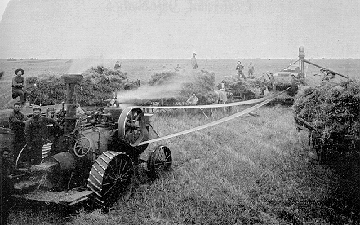 |
|
A Photo From The 1867 - 1967 Centennial Booklet Finishing the wheat harvest in the fall meant hauling the shocked wheat to a thrashing machine such as this powered by a steam engine. As it was thrashed, it had to be bagged and loaded onto wagons for offloading at the granary. The hard physical labor required of the thrashing crew made wheat thrashing dinners a treat to look forward to. The most unpleasant thing that could happen was an abrupt change in wind direction. Wheat chaff on sweaty skin and down one's neck made long fingernails a blessing. Long sleeves and buttoned collars were a must even in warm weather. There are 21 men working this operation. Today's combines are aptly named. They combine cutting, eliminate shocking and hauling, and thrash and bin the wheat for auguring off on a semi trailer. One man or woman can handle the whole operation. The investment in machinery is cheaper and quicker than the investment in labor would be. |
 |
|
Bathgate Sentinel of 1883 is reproduced as it appeared in the May 1998 issue of the Newsletter for the Icelandic Klub of the Fargo-Moorhead Area * * * * * * * * * * * * 115 years ago... What was it like for our ancestors, not even speaking the language, to establish themselves in this new country? The following, though not specifically about the Icelanders, was written at the time of their settlement in Dakota, and explains somewhat one particular aspect of their new lives - the costs and methods of homesteading. Operating a Dakota
Farm It is strange what queer ideas some eastern people have when they first come to Dakota. Some of them seem to have lost their reason entirely in their excitement and anxiety to get a "farm.” They have read a copy of the government land laws and seem to imagine that the only thing required is to select a quarter section of government land and then sit down on the section corner and wait for the shekels to accumulate. Not one out of a dozen of the young men has counted the time and expense incurred in securing a quarter section of government land. They have figured correctly on the cost of filing and proving up and here their reason seems to have left them. The present law requires a claimant to expend at least $250 in improvements on his pre-emption before the government will grant him a patent, besides he must reside on his claim six months. The claimant can use his own judgment in placing his improvements. It requires money to buy lumber and build a house and it requires money to hire breaking done, if he has no team of his own, and if he has it takes money to buy feed and breaking plows, for it must be remembered that very little is given away in this country. The cost of living he estimates nearly correctly as it costs but very little more here in Dakota than does in the states east. A young man's incidentals will be regulated according to his tastes but they are generally considerable. Many claim holders can obtain enough employment during their time of residence to defray their living expenses, especially mechanics, but the rulings are very strict of late regarding residence and if his absence is too prolonged the government detective will likely make him trouble. If the law is rigidly adhered to a quarter section of government land will cost about as follows: Locating $10.00 This land will be worth when deeded from $6 to $10 per acre without additional improvements; the average price is about $8 per acre, or $1280 for the quarter. This would leave the owner a net profit of $755 for his six months' work - a good profit, indeed, but it required an outlay of $525 to secure it. We have known of scores of men to come to Dakota with scarcely a hundred dollars who expected to pre-empt a claim, prove up, and return in six months worth $1500. Such men generally go back disappointed and write letters to their home papers defaming Dakota and advising people to stay away. Men who have carefully counted the cost before starting are the ones who hold valuable claims and who are aiding in the development of the country and growing rich from their labors. Dakota is full of poor men who are growing rich but they are men of good, sound judgment, indomitable pluck, and enterprise. This is no place for drones and sluggards. They had better stay away, but for men of limited means, who are possessed of grit and pluck there is not a country on the face of the globe that offers better inducements. Where under the sun can a man obtain 160 acres of rich farming land with six months' labor and an outlay of $500 except on the prairies of the west? But there are persons so carried away with excitement and so devoid of practical reason as to expect such a gift for nothing. |
|
|